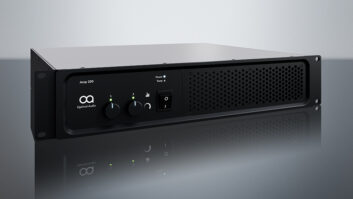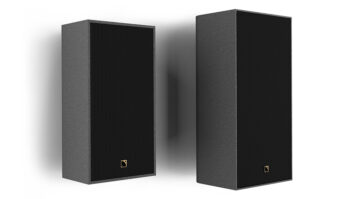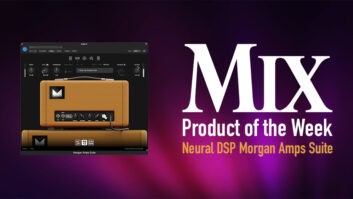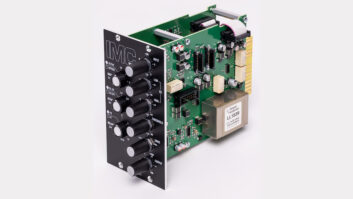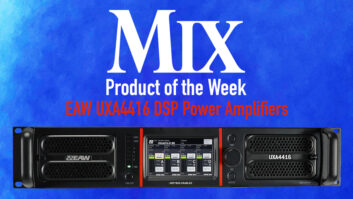
Lab.gruppen has a well-deserved reputation for manufacturing some pretty impressive power amplifiers. Its FP+ Series touring amplifiers incorporate a number of technological advances, including the company’s patented Class-TD circuitry, which — according to the manufacturer — combines the efficiency of Class-D amplification with the sonic attributes of Class-B. Class-TD works with a regulated switch-mode power supply that ensures stable, full-power output over a wide range of voltage input. When used with Lab.gruppen’s NLB 60E Ethernet Bridge, FP+ amplifiers are compatible with NomadLink, the company’s proprietary network for PC control and monitoring.
THE BEAST
For this review, I tested Lab.gruppen’s FP7000 (pictured) and FP10000Q power amps. The FP10000Q ($6,495) is a 4-channel amp rated at 2,100 watts per channel into 4 ohms or 2,500W/channel into 2 ohms. When bridged, it pumps out 4,200W (x2) into 8 ohms or 5,000W (x2) into 4 ohms. The FP7000 ($5,095) 2-channel amp can deliver 2,800W/channel into 4 ohms, 3,500W/channel into 2 ohms or up to 7,000W when bridged. Both models occupy two rackspaces and weigh 26 pounds. The review units featured binding post outputs, but versions are available with Speakon terminals. All versions employ balanced XLR inputs (pin 2 hot). The FP7000 provides loop-through connectors, while the FP10000Q does not.
I used the units for L/R mains and monitor systems. At several shows, the FP10000Q powered both the mains and monitor systems (two channels each). Mains were JBL PRX and SRX Series cabinets, and monitors were Yamaha SM12Vs. Typically, one cabinet was driven per channel, but in a few cases two SM12Vs were paralleled from one output.
My FP+ amps came with a 30-amp twist-lock on a nonremovable power cable, which I found disappointing. A quick trip to a local electrical supply store yielded a mating female connector, which I used to make an adapter. In addition to the power cable, the rear panel includes the previously mentioned I/O connectors, NomadLink ports and DIP switches for amplifier gain, bridging, fan “masking” and voltage-peak limiter (VPL).
THE BEAUTY
These amps incorporate several circuits designed to protect the amplifier and your loudspeakers. DIP switches set the amplifier gain, which affects sensitivity (making it easy to optimize both signal-to-noise and headroom), while front panel pots are used for making fine adjustments to the input level. Having these controls might seem redundant, but this is not the case; think of it as having a mic/line/instrument selector on a console input, plus a trim pot for tweaking.
The VPL is a unique feature of the FP+ Series. It sets maximum peak output per channel in increments from 38 to 150 volts (FP10000Q) or 155 volts (FP7000). VPL matches peak power output to your loudspeaker to protect your drivers. This was a welcome feature when connecting those Yamaha monitors, which could potentially be damaged if driven by the full muscle of an FP+. It was even more welcome when driving the mid-/high-frequency section of JBL SRX738 cabs in bi-amp mode, which requires far less power than what the FP10000Q is capable of delivering.
Using the FP+ amps was a joy. Soft turn-on ensures that you won’t blow a mains fuse when powering up — no small consideration for a device that can draw between 5 and 30 amps from the AC supply. Front panel controls are minimal but show essential input level and fault status, and the right rack handle shields the power switch from accidental tripping. One nitpick I have is that the binding post connectors must be inserted alongside the edge of the rear panel instead of perpendicular to it, as on most power amps. This probably won’t be a big deal, but it might require an empty rackspace above and below the amp. (Lab.gruppen includes rear mounts to prevent damage when the amp is installed in a mobile rack.)
All FP+ Series amps are compatible with Lab.gruppen’s NomadLink network with the addition of the NLB 60E Ethernet network bridge ($1,245), which interfaces the amps with a PC. NomadLink connections use RJ45 hardware and DeviceControl software (PC only) to identify the amps on the network automatically and generate a list of amps onscreen. Amps may be powered on or off; monitored for faults, shorts and error warnings; and muted on a per-channel basis. At one point, I had a speaker cable with a short in it, and the FP10000Q muted the shorted channel while indicating “mute” on the front panel. Changing the faulty cable relieved the problem.
CLEAR AND POWERFUL WINNER
It’s very apparent that FP+ amps have total control over the loudspeakers that they are driving. The low end is powerful and very tight without slop or hangover, while the mid- and high frequencies are as clearly defined and transparent as the input signal. Background noise is present only if your source is generating it. Using the FP10000Q allows stereo bi-amping with one power amp that can be lifted by a single person. At no time during operation did the amps run any more than warm to the touch.
These amplifiers sound great and provide a lot of headroom, which fits my credo: “You can never have enough power!” When you drive a Ferrari, you don’t always surpass the speed limit, but it’s nice to know that the muscle is there if you need it.
Lab.gruppen, 818/665-4900, www.labgruppen.com.

